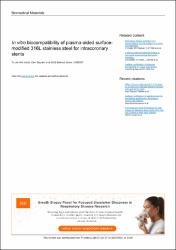| dc.contributor.author | Bayram, Cem | |
| dc.contributor.author | Mızrak, Alpay Koray | |
| dc.contributor.author | Aktürk, Selçuk | |
| dc.contributor.author | Kursaklioglu, Hurkan | |
| dc.contributor.author | Iyisoy, Atila | |
| dc.contributor.author | Ifran, Ahmet | |
| dc.contributor.author | Denkbas, Emir Baki | |
| dc.date.accessioned | 2020-11-20T16:33:53Z | |
| dc.date.available | 2020-11-20T16:33:53Z | |
| dc.date.issued | 2010 | |
| dc.identifier.issn | 1748-6041 | |
| dc.identifier.uri | https://doi.org/10.1088/1748-6041/5/5/055007 | |
| dc.identifier.uri | https://hdl.handle.net/20.500.12809/4513 | |
| dc.description | WOS: 000282277300025 | en_US |
| dc.description | PubMed ID: 20844318 | en_US |
| dc.description.abstract | 316L-type stainless steel is a raw material mostly used for manufacturing metallic coronary stents. The purpose of this study was to examine the chemical, wettability, cytotoxic and haemocompatibility properties of 316L stainless steel stents which were modified by plasma polymerization. Six different polymeric compounds, polyethylene glycol, 2-hydroxyethyl methacrylate, ethylenediamine, acrylic acid, hexamethyldisilane and hexamethyldisiloxane, were used in a radio frequency glow discharge plasma polymerization system. As a model antiproliferative drug, mitomycin-C was chosen for covalent coupling onto the stent surface. Modified SS 316L stents were characterized by water contact angle measurements (goniometer) and x-ray photoelectron spectroscopy. C1s binding energies showed a good correlation with the literature. Haemocompatibility tests of coated SS 316L stents showed significant latency (t-test, p < 0.05) with respect to SS 316L and control groups in each test. | en_US |
| dc.description.sponsorship | Scientific and Technological Research Council of TurkeyTurkiye Bilimsel ve Teknolojik Arastirma Kurumu (TUBITAK); Health Sciences Research Group (SBAG)Turkiye Bilimsel ve Teknolojik Arastirma Kurumu (TUBITAK) [106S182] | en_US |
| dc.description.sponsorship | This work was funded by The Scientific and Technological Research Council of Turkey, Health Sciences Research Group (SBAG) project number 106S182. Additionally, the stents used in this study were kindly gifted by Alvimedica Medical Inc., Turkey. | en_US |
| dc.item-language.iso | eng | en_US |
| dc.publisher | Iop Publishing Ltd | en_US |
| dc.item-rights | info:eu-repo/semantics/openAccess | en_US |
| dc.title | In vitro biocompatibility of plasma-aided surface-modified 316L stainless steel for intracoronary stents | en_US |
| dc.item-type | article | en_US |
| dc.contributor.department | MÜ, Fen Fakültesi, Fizik Bölümü | en_US |
| dc.contributor.institutionauthor | Aktürk, Selçuk | |
| dc.identifier.doi | 10.1088/1748-6041/5/5/055007 | |
| dc.identifier.volume | 5 | en_US |
| dc.identifier.issue | 5 | en_US |
| dc.relation.journal | Biomedical Materials | en_US |
| dc.relation.publicationcategory | Makale - Uluslararası Hakemli Dergi - Kurum Öğretim Elemanı | en_US |


















